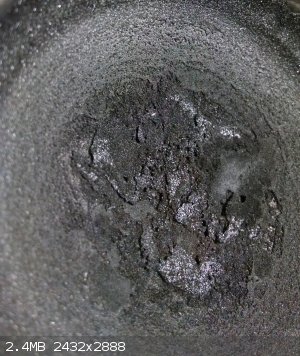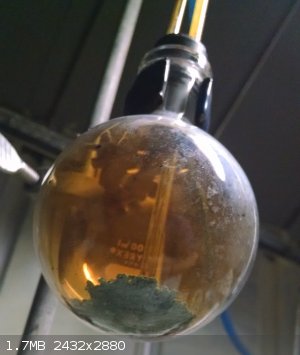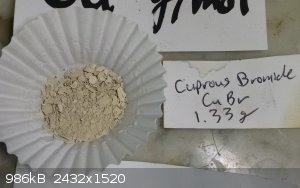TheMrbunGee
Hazard to Others
  
Posts: 364
Registered: 13-7-2016
Location: EU
Member Is Offline
Mood: Phosphorising
|
|
Bromoacetone from Copper (II) Bromide
So I was just experimenting with Copper bromide, reacted HBr with CuO, got green solution, I evaporated off the water and it became violet, dried it
more and It became grey!
That is all fine, strange was that I tried to purify it by dissolving it (purple stuff) in acetone, so again - In lower concentrations solution was
dark green and higher concentration solutions was dark violet! It was really nice looking color change, so I took some of solution and put in small
vial (air tight, ember glass, in a dark place)
Two days later - something that really bring tears in my eyes had happened! Literally! Solution (which was really dark green) has turned pale green,
and I now have tear gas in the vial! 
Okay, I understand, that bromoacetone has formed, but the real question is - where did the copper go? There is no precipitate, and the color is
nearly gone! What colorless copper compound has formed?
|
|
|
woelen
Super Administrator
        
Posts: 8014
Registered: 20-8-2005
Location: Netherlands
Member Is Offline
Mood: interested
|
|
The copper is reduced to copper(I) and this apparently forms a complex with acetone.
I think that a redox reaction occurred, something like
2 CuBr2 + CH3COCH3 ----> 2 CuBr + HBr + CH2BrCOCH3
The CuBr most likely formed a soluble complex, either with acetone or with the bromoacetone. CuBr is colorless, the acetone-adduct apparently also is
colorless.
Try adding a few drops of the liquid to cold water. I expect formation of a white precipitate, which in contact with air quickly turns dirty
brown/green, due to oxidation by oxygen from air.
|
|
|
JJay
International Hazard
    
Posts: 3440
Registered: 15-10-2015
Member Is Offline
|
|
Very interesting. I wonder if CuBr in acetone will react with aluminum. CuCl2 in acetone does not, or if it does, the reaction is not very vigorous at
room temperature. I played around with it a while back to see if I could find a quick and easy means to form aluminum chloride but set it aside when I
learned that aluminum chloride is difficult to remove from acetone.
I'm not sure if CuCl2 will produce chloroacetone with acetone at room temperature with no catalyst, but at no point did I notice any lachrymatory
fumes.
Of course, CuCl2 in water cuts through aluminum like a hot bandsaw through Crisco. I assume that CuBr2 will do the same.
[Edited on 14-12-2016 by JJay]
|
|
|
AvBaeyer
National Hazard
   
Posts: 651
Registered: 25-2-2014
Location: CA
Member Is Offline
Mood: No Mood
|
|
The reaction of copper(II) halides with ketones to give monohaloketones is a well recognized reaction. One of the first people to study this was J
Kochi who had several JACS papers on this. If you use Google scholar and search for Kochi's papers then look at the citations you will find plenty of
information. As it turns out, ketone halogenation with Cu(II) halides is a very useful synthetic reaction.
AvB
|
|
|
TheMrbunGee
Hazard to Others
  
Posts: 364
Registered: 13-7-2016
Location: EU
Member Is Offline
Mood: Phosphorising
|
|
| Quote: |
I wonder if CuBr in acetone will react with aluminum
|
It does not!
| Quote: |
Of course, CuCl2 in water cuts through aluminum like a hot bandsaw through Crisco. I assume that CuBr2 will do the same.
|
It does react, but not as vigorous!
| Quote: |
Try adding a few drops of the liquid to cold water. I expect formation of a white precipitate, which in contact with air quickly turns dirty
brown/green, due to oxidation by oxygen from air.
|
It did formed white precipitate, I just did the experiment, It has not turned green/brown yet!
Thanks for the answers, guys!  As always - very helpful! As always - very helpful! 
|
|
|
JJay
International Hazard
    
Posts: 3440
Registered: 15-10-2015
Member Is Offline
|
|
This paper (one of Kochi's early ones) says that rate of the reaction is dependent on halide ion concentration, in particular, chloride....
TheMrbunGee, is it possible that there was some water present in your acetone or copper (ii) bromide?
Attachment: ja01625a016.pdf (652kB)
This file has been downloaded 813 times
|
|
|
TheMrbunGee
Hazard to Others
  
Posts: 364
Registered: 13-7-2016
Location: EU
Member Is Offline
Mood: Phosphorising
|
|
Quote: Originally posted by JJay  | This paper (one of Kochi's early ones) says that rate of the reaction is dependent on halide ion concentration, in particular, chloride....
TheMrbunGee, is it possible that there was some water present in your acetone or copper (ii) bromide? |
Yes, it had, I evaporated the water @ 40°C, and because the bromide is hydroscopic - some water was present! And the concentration was high, I
dissolved about 10g of bromide in about 40ml of acetone.
|
|
|
JJay
International Hazard
    
Posts: 3440
Registered: 15-10-2015
Member Is Offline
|
|
I wonder if the reaction would still take place if you used really dry acetone and dehydrated your CuBr2 at 300 C for several hours.
It does look as though the method you used is one of the safest ones for preparing a haloketone.
[Edited on 15-12-2016 by JJay]
|
|
|
TheMrbunGee
Hazard to Others
  
Posts: 364
Registered: 13-7-2016
Location: EU
Member Is Offline
Mood: Phosphorising
|
|
Quote: Originally posted by JJay  | I wonder if the reaction would still take place if you used really dry acetone and dehydrated your CuBr2 at 300 C for several hours.
It does look as though the method you used is one of the safest ones for preparing a haloketone.
[Edited on 15-12-2016 by JJay] |
I would try it, but I ran out of acetone!  Not sure, when I am going to get
some more! :? Not sure, when I am going to get
some more! :?
About that - yes, and I think there is a pretty decent yield!  Haven't tried to
purify it, I really suck it the field of equipment! Haven't tried to
purify it, I really suck it the field of equipment! 
|
|
|
JJay
International Hazard
    
Posts: 3440
Registered: 15-10-2015
Member Is Offline
|
|
I'm thinking about giving it a try on an extremely small scale....
|
|
|
AvBaeyer
National Hazard
   
Posts: 651
Registered: 25-2-2014
Location: CA
Member Is Offline
Mood: No Mood
|
|
Here are some papers from my files which point to the broad utility of Cu(II) halides as halogenation reagents. A wide variety of solvents can be used
for the reaction. I have used ethyl acetate and chloroform as solvents with excellent results. Cupric chloride is easily available but seems to
require lithium chloride as an activator for good results. Cupric bromide is much more reactive but is difficult to find and often quite expensive.
Interestingly, cupric bromide is reactive enough that it can used catalytically in conjunction with eg potassium bromide for bromination reactions.
Have a look at these papers. The cupric halides are interesting reagents for examination in the home lab.
AvB
Attachment: Cupric Chloride halogenation JOCv28p630 .pdf (561kB)
This file has been downloaded 441 times
Attachment: Cupric Halide Halogenations Castro paper.pdf (704kB)
This file has been downloaded 409 times
Attachment: Reactions of Some Organic Compounds with Cupric Bromide fort1961.pdf (336kB)
This file has been downloaded 487 times
Attachment: Reduction of Cupric Chloride by Carbonyl Compounds Kochi.pdf (617kB)
This file has been downloaded 425 times
|
|
|
mayko
International Hazard
    
Posts: 1218
Registered: 17-1-2013
Location: Carrboro, NC
Member Is Offline
Mood: anomalous (Euclid class)
|
|
| Quote: |
I wonder if the reaction would still take place if you used really dry acetone and dehydrated your CuBr2 at 300 C for several hours.
|
Heads up: cupric bromide is not very heat-stable. At high temperature, it will decompose to cuprous bromide and elemental bromine:
2CuBr2 -> 2CuBr + Br2
This happens at fairly low temperatures, so I'm not sure where the literature melting point comes from. Brauer says the decomposition occurs on "dry
heating", but I don't know how 500C could be called a wet heat. Brauer also says that solutions of cupric bromide decompose at the boiling point, but
I did not observe this. This is probably why the preferred drying method is in vacuum over a desiccant. I had good results by heating an aqueous
solution in a water bath most of the way, then adding portions of anhydrous ethanol to evaporate off the water azeotrope, then heating the rest of the
alcohol off below the bp of water. But, good luck getting it bottled before it absorbs ambient moisture! 
I mention this both because it sounds like the decomp is being described here:
| Quote: |
I evaporated off the water and it became violet, dried it more and It became grey!
|
and as a safety consideration, so no one is caught unawares by bromine fumes   
Solid copper bromide is a purple-black crystalline solid, looking very much like elemental iodine. (I'd hesitate to call it violet, though the cobalt
salt is a spectacular lavender) It's far and away the most deliquescent substance I've ever seen:

Cuprous bromide and lingering bromine, after heating the cupric salt:

Cuprous bromide after washing:

al-khemie is not a terrorist organization
"Chemicals, chemicals... I need chemicals!" - George Hayduke
"Wubbalubba dub-dub!" - Rick Sanchez
|
|
|
JJay
International Hazard
    
Posts: 3440
Registered: 15-10-2015
Member Is Offline
|
|
Quote: Originally posted by mayko  |
| Quote: |
I wonder if the reaction would still take place if you used really dry acetone and dehydrated your CuBr2 at 300 C for several hours.
|
Heads up: cupric bromide is not very heat-stable. At high temperature, it will decompose to cuprous bromide and elemental bromine:
2CuBr2 -> 2CuBr + Br2
|
Interesting. Apparently, this decomposition can be detected at temperatures as low as 50 C, and it continues to completion above 280 C... so drying at
300 C is definitely not a good idea. Wikipedia says to dry CuBr2 over phosphorus pentoxide.
It looks to me as though the kinetics for the ketone halogenation reactions of different copper halides would be very different.
I'm burning with curiousity about what would happen if you refluxed aluminum turnings with toluene, acetone, and CuBr2.
[Edited on 16-12-2016 by JJay]
|
|
|
Metacelsus
International Hazard
    
Posts: 2539
Registered: 26-12-2012
Location: Boston, MA
Member Is Offline
Mood: Double, double, toil and trouble
|
|
I've seen papers using Li2CuBr4 and Li2CuCl4 as mild halogenating agents, but in general the system has to
be highly activated towards halogenation.
Edit: Fixed typo
[Edited on 12-16-2016 by Metacelsus]
|
|
|
JJay
International Hazard
    
Posts: 3440
Registered: 15-10-2015
Member Is Offline
|
|
I do wonder what exactly is going on here... it seems likely that aluminum is initially unreactive towards CuBr2 in acetone because of the
protective oxide layer... I suspect it would react pretty readily with an amalgam, but finding out by experiment requires being set up to deal with
mercury waste.
[Edited on 16-12-2016 by JJay]
|
|
|
careysub
International Hazard
    
Posts: 1339
Registered: 4-8-2014
Location: Coastal Sage Scrub Biome
Member Is Offline
Mood: Lowest quantum state
|
|
Quote: Originally posted by AvBaeyer  | Here are some papers from my files which point to the broad utility of Cu(II) halides as halogenation reagents.
|
Any thoughts or insights how it might compare to making/using NBS for bromination (in either case I would need to prepare the bromination agent)?
About that which we cannot speak, we must remain silent.
-Wittgenstein
Some things can never be spoken
Some things cannot be pronounced
That word does not exist in any language
It will never be uttered by a human mouth
- The Talking Heads
|
|
|
DraconicAcid
International Hazard
    
Posts: 4334
Registered: 1-2-2013
Location: The tiniest college campus ever....
Member Is Offline
Mood: Semi-victorious.
|
|
Quote: Originally posted by Metacelsus  | | I've seen papers using LiCuBr4 and LiCuCl4 as mild halogenating agents, but in general the system has to be highly activated
towards halogenation. |
LiCuBr4 would contain Cu(III) and wouldn't be mild anything. Li2CuBr4?
Please remember: "Filtrate" is not a verb.
Write up your lab reports the way your instructor wants them, not the way your ex-instructor wants them.
|
|
|
Metacelsus
International Hazard
    
Posts: 2539
Registered: 26-12-2012
Location: Boston, MA
Member Is Offline
Mood: Double, double, toil and trouble
|
|
Yep, typo.
|
|
|
AvBaeyer
National Hazard
   
Posts: 651
Registered: 25-2-2014
Location: CA
Member Is Offline
Mood: No Mood
|
|
careysub:
In response to "Any thoughts or insights how it might compare to making/using NBS for bromination (in either case I would need to prepare the
bromination agent)?"
I would generally favor NBS or 1,3-dibromo-5,5-dimethylhydantoin (DBDMH) which is easily and very cheaply available relative to NBS. With a catalytic
amount of p-TosOH, DBDMH easily and mildly brominates, for example, acetophenone and ethyl acetoacetate. I can post a tested procedure for this if you
would like as well as some supporting references.
The only time I have found cupric bromide singularly advantageous was in the bromination of acetylpyridines. The reaction is run in ethyl
acetate/chloroform and the product is the hydrobromide salt of the brominated ketone (soluble in the reaction solvent) thereby providing protection
from self reaction.
(Un)forunately, not too long ago I got nearly a half-kilo of cupric bromide so now I will have to find something useful to do with it.
AvB
|
|
|
careysub
International Hazard
    
Posts: 1339
Registered: 4-8-2014
Location: Coastal Sage Scrub Biome
Member Is Offline
Mood: Lowest quantum state
|
|
Quote: Originally posted by AvBaeyer  |
I would generally favor NBS or 1,3-dibromo-5,5-dimethylhydantoin (DBDMH) which is easily and very cheaply available relative to NBS.
|
I have succinic acid and so could *make* NBS from bromine.
I have not found DBDMH to be easily available on a recent search, only BCDMH (1-Bromo-3-chloro-5,5-dimethylhydantoin).
Products that are listed in recent MSDS's (even ones dated as revised this year), and on-line, as being DBDMH were, on actual inspection of the
shipping product to be BCDMH, which may serve, but with chlorine contamination.
Does anyone know of a product currently available consisting of DBDMH?
About that which we cannot speak, we must remain silent.
-Wittgenstein
Some things can never be spoken
Some things cannot be pronounced
That word does not exist in any language
It will never be uttered by a human mouth
- The Talking Heads
|
|
|
JJay
International Hazard
    
Posts: 3440
Registered: 15-10-2015
Member Is Offline
|
|
I've seen TBCA sold locally at department stores as a brominating agent for spas, but it doesn't seem to be very popular among amateur chemists.
I imagine it's a little more unwieldy to use than NBS.
[Edited on 17-12-2016 by JJay]

|
|
|
careysub
International Hazard
    
Posts: 1339
Registered: 4-8-2014
Location: Coastal Sage Scrub Biome
Member Is Offline
Mood: Lowest quantum state
|
|
I followed up on a few leads sent to me, and did a bit more investigation and have confirmed that DBDMH is entirely gone from the market.
I have even gotten responses from two major "bromo tab" vendors (as well as two major distributors) and they have all confirmed that no DBDMH exists
in any of the products they make/carry (but, see, this is an *improvement* I am assured).
Curious that this seems to have happened to the entire market within the last couple of years.
All products that formerly had it (even if the manufacturer and seller still claims that it is all bromine) now have the bromo-chloro version.
If anyone can actually find some (possibly old stock) please let me know.
Currently the only source seems to be ordering from China.\
[Edited on 17-12-2016 by careysub]
[Edited on 18-12-2016 by careysub]
About that which we cannot speak, we must remain silent.
-Wittgenstein
Some things can never be spoken
Some things cannot be pronounced
That word does not exist in any language
It will never be uttered by a human mouth
- The Talking Heads
|
|
|
careysub
International Hazard
    
Posts: 1339
Registered: 4-8-2014
Location: Coastal Sage Scrub Biome
Member Is Offline
Mood: Lowest quantum state
|
|
The DBDMH saga continues (maybe this should be its own thread).
I have just been alerted by a vendor that Brilliance For Spas Sanitizer (NOT Bromo Tabs) still contains DBDMH.
I am ordering some to see if this is really true.
I have been burned before by advertised products showing DBDMH on the label (and on the website advertising, and on the MSDS) but not having it when I
received it, but this vendor is telling me that they have this in stock.
[Edited on 18-12-2016 by careysub]
About that which we cannot speak, we must remain silent.
-Wittgenstein
Some things can never be spoken
Some things cannot be pronounced
That word does not exist in any language
It will never be uttered by a human mouth
- The Talking Heads
|
|
|